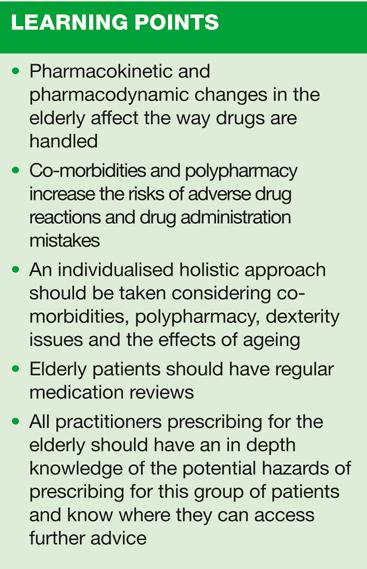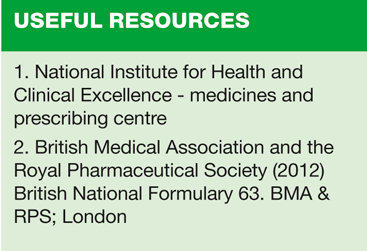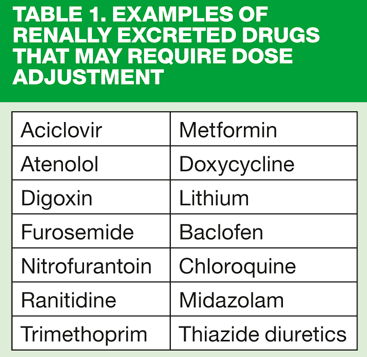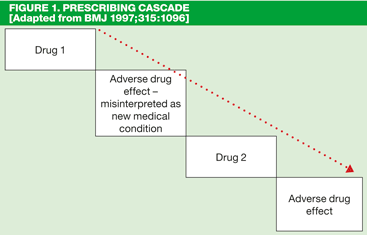Prescribing for the Elderly
Stephanie Garner
Stephanie Garner
RGN, BSc Nurse Practitioner
Primary and Community Care, Independent/Supplementary Prescriber
Association of Nurse Prescriber's committee member
Advanced Nurse Practitioner, Wisbech
Elderly patients present particular challenges for the nurse prescriber, and prescribing to meet their complex needs requires additional knowledge and careful consideration
The 'prescription of medicines is the most common form of therapeutic intervention in medicine',1 therefore, ensuring consistent quality within prescribing is essential for all patients. However, the older population presents special challenges due to increased co-morbidities, polypharmacy, the natural ageing process and increased frailty. All these contributing factors increase the elderly patient's risk of developing a drug related problem, thus prescribing for the elderly to meet their complex needs requires knowledge, thought and careful planning.
In England, one fifth of the population is aged over 60 years and this group is prescribed 52% of all prescriptions.2 It is estimated that 80% of the over 75 year old population take at least one medication daily, with 36% of this age group taking four or more different medications.3
While it may be necessary for older patients to be prescribed multiple medications to prevent progression of chronic diseases, the misuse and often overuse of medications has been shown to increase serious adverse drug reactions (ADRs) including hospitalisations and death.4 It has been suggested that up to 25% of elderly admissions may be due to ADRs, with up to 50% of all ADRs being described as preventable.5
To be able to prescribe safely for older patients requires consideration of four main areas: knowledge of the ageing process and the drugs being prescribed, proof of medication efficacy, vigilance for adverse drug reactions and simplifying medication regimens to avoid where possible polypharmacy.6
PHARMACOLOGY IN RELATION TO AGEING
Ageing is a progressive physiological process that is characterised by degeneration of organ systems and loss of, or reduction in, their function. This not only leads to chronic diseases such as diabetes, kidney disease and heart disease but can have a profound effect on the way the body handles medications. The complicating factor in elderly patients is differentiating between disease process changes (which can be complicated further by co-morbidities) and natural age-related changes. Therefore, when prescribing for the elderly, an in-depth knowledge of both is essential, to prevent unnecessary prescribing.
Pharmacokinetics
Pharmacokinetics is the process of how the body handles a drug and relates to the actions of absorption, distribution, metabolism and elimination.
Absorption: There is very little change in ability to absorb as we age, but due to decreased saliva production, decreased gastric emptying and reduced gastrointestinal mobility, the rate of absorption may be slowed down. However some authors suggest this is more likely to be a co-morbidity effect rather than purely an age-related change. Drugs such as calcium channel blockers, proton pump inhibitors and beta blockers commonly prescribed in the elderly can themselves cause a reduction in gastric emptying.
Distribution affects the amount of drug available at its target site. The elderly have reduced total body water hence there is a reduction in distribution of water soluble drugs such as digoxin; conversely, increased body fat results in higher volume of distribution of fat soluble drugs such as diazepam. These factors together with decreased muscle mass may result in changes to steady state.
The extent and pattern of distribution depends on the plasma and tissue protein binding capacity of the drugs. Decreased serum albumin alone is not clinically significant but diseases that affect albumin levels and malnutrition are both more common in the elderly, thus dose reductions are usually required for heavily protein-bound drugs such as warfarin or phenytoin as there will be more unbound drug available for distribution.
Metabolism: With ageing, liver mass decreases and, together with decreased hepatic blood flow, this in turn reduces first pass metabolism. The result of this is higher bioavailability of drugs and greater potential for toxicity; this is especially pronounced in drugs with decreased hepatic clearance such as digoxin, benzodiazepines, beta blockers and antidepressants. It should also be remembered that smoking, alcohol and polypharmacy may influence metabolism as much as, if not more than the natural ageing process, so combining these factors will increase these effects.
Elimination: Decreased renal blood flow, glomerular filtration rate and creatinine clearance are all effects of ageing, resulting in a decrease in the elimination of renally excreted drugs; this means the half life is prolonged and consequently serum levels are increased. The clinical significance of this is more pronounced in drugs with a narrow therapeutic range (Table 1) such as digoxin, hence regular assessment of these functions is essential. (Remember creatinine levels may remain normal but creatinine clearance decreases by 50% between the ages of 25yrs and 85yrs).
Diabetes and nephrotoxic drugs such as non steroidal anti-inflammatory drugs (NSAIDS) and angiotensin converting enzyme inhibitors (ACE inhibitors) can also affect renal function, so for diabetic patients or those who have been prescribed nephrotoxic medications at any age will be more likely to have a decreased renal function as they get older.
As we age the time to peak plasma concentration of digoxin increases from a mean of 38 hours in the young to approximately 69 hours in older patients.7 This has the effect of increasing the time taken to reach steady state from 7 days to 12 days. Combined with a decreased volume of distribution and a decreased elimination process if doses are not reduced, toxic effects are likely.
Most ACE Inhibitors are pro-drugs and are activated in the liver, so problems with liver function and renal function will affect the levels. Excretion of ACE inhibitors is dependent on efficient glomerular filtration and tubular secretion, so unless doses are reduced in patients with impaired kidney function, these combined effects again increase the risk of ADRs.
Pharmacodynamics
Pharmacodynamics is the process of what the drug does to the patient, and describes the relationship between drug concentration at the site of action and the resulting effect. The drug effect is determined by its interaction with target molecules — either increasing or decreasing the rate of action of enzymes; facilitating transport across cell membranes; opening or closing ion channels; and either working with (agonist effect), against (antagonist effect) or by blocking, receptor sites.
Changes to pharmacodynamic processes in the elderly are far less well documented than pharmacokinetic changes, but it is recognised that there are changes in receptor numbers and receptor affinity. The central nervous system and cardiovascular system appear particularly affected, with enhanced responses to drugs being demonstrated. It is not uncommon to see confusion and drowsiness in patients taken benzodiazepines, or postural hypotension in patients on antihypertensive medications both of which potentially lead to increased risks of falls and fractures.
BALANCING RISKS AND BENEFITS
With all long term conditions treatment guidelines are available to aid in the decision making processes, however with co-morbidities there may be conflicting advice on what may be suitable to prescribe due to interactions of the recommended medications or their use in certain conditions e.g. beta blockers are recommended following myocardial infarction but may be contra-indicated in patients with asthma. It should also be remembered that while the elderly should not be excluded from receiving recommended treatments, many drugs have not been specifically tested on the elderly population in clinical trials.
In the past there have been several attempts to make lists of medications that may be more harmful, the most common of these being the Beers criteria initially published in 1991 by the Journal of the American Geriatric Society,8 which listed the higher risk drugs and the rationale for not using them in the elderly population. Although a valuable resource, it was based around commonly used American drugs and there were concerns in that 50% of the drugs were not available in Europe. Other concerns were that these criteria lacked efficacy data relating to ADR reduction and cost effectiveness, and that there were many omissions.
STOPP & START criteria
More recently, 18 geriatric pharmacotherapy experts from Ireland and the UK developed an evidence based medication review toolkit designed to identify medications where the risks outweigh the benefits in the elderly and vice versa.9 The toolkit consists of two elements — the Screening Tool of Older Persons, potentially inappropriate Prescriptions (STOPP) and the Screening Tools to Alert doctors to the Right Treatment (START). The STOPP criteria consist of 68 rules relating to the most common and potentially dangerous instances of inappropriate prescribing, whereas the START criteria relate to 22 rules relating to the commonest drug omissions.
The STOPP and START criteria are based on the chapters of the British National Formulary (BNF) and give advice on what to START in the over 65 age group and what to consider STOPPing. As with all prescribing decision-making, the process should be tailored to the individual patient, as there is between-patient variability in when the risks associated with a medication begin to outweigh its benefits. These criteria can help identify higher risk medications that may need adjusting to help prevent ADRs, and highlight the need for regular medication reviews and monitoring to detect problems early.
Recognising symptoms as adverse drug reactions
Distinguishing symptoms as a medication side effects or a result of normal ageing effects can be difficult; when coupled with co-morbidites and polypharmacy this exacerbates the problem. The prescribing cascade (Figure 1) highlights how unnecessary medication may be prescribed for symptoms seen as new conditions which are indeed ADRs with new medications added to treat it. This increases the risk of developing further side effects from the new medication or interactions with the other medications they are taking.
Remember, drugs may also mimic diseases. One such drug is metoclopramide, which can induce acute dystonic reactions mimicking Parkinson's disease. If this is not recognised as a side effect and levo dopa is prescribed, the risk of side effects such as postural hypotension, confusion, arrythmias and psychosis increases, which in turn could result in hospital admission.
PRESCRIBING CAUTIOUSLY
Polypharmacy is a well-recognised problem in the elderly with numerous studies showing that elderly patients often continue using drugs that are no longer indicated.10 Repeat prescribing is a danger area where there is the potential for medication to be repeatedly prescribed when it is no longer required. For example, clopidogrel is recommended for differing durations depending on the indication it is given for, therefore it is essential its use is reviewed regularly to prevent overprescribing.
When commencing a new medication the approach of 'start low and go slow' is usually recommended. Starting with a lower dose of the medication and making gradual increases if necessary until the lowest therapeutic dose is achieved. However, while this approach reduces the chance of unpredictable effects, it should also be remembered that seriously ill patients may need a prompt therapeutic response and thus starting low and going slow may not always be appropriate.
Medications that are known to be safer in the elderly should always be used first line. The BNF is a valuable resource that identifies any cautions that should be considered when prescribing for the elderly. Routledge et al,11 suggest antibiotics, anticoagulants, digoxin, diuretics, hypoglycaemic agents, antineoplastic agents and nonsteroidal anti-inflammatory drugs (NSAIDs) are responsible for 60% of ADRs leading to hospital admission. They identify these ADRs as type A reactions i.e 'an accentuation of the known pharmacological effect of the drug,' which are often dose related, and thus 'predictable and potentially avoidable'.
PROMOTING CONCORDANCE
NICE12 suggests that over half of patients do not take their medications as prescribed, either as a result of lack of understanding, adverse events, dexterity issues or simple forgetfulness. Taking medicines incorrectly or not at all can lead to disease complications, adverse effects and increase the financial burden to the NHS.
It is essential medicine concordance is checked at every appointment: patients may have stopped taking medications themselves and it is vital to find out why; is this related to an adverse effect, an inability to take it, forgetting what should be taken when or simply not requiring the medication any longer.
We know that with the ageing process, there may be deterioration in memory function, so it is good practice to employ other safe prescribing practices in elderly patients, such as using:
- Simplified dosing regimes
- Modified or sustained release preparations
- Drugs that don't interact with each other so that they can be taken at the same time
- Once or twice daily dosing regimes
These tactics may help avoid confusion that may occur with more complex dosing patterns.
It may be necessary to think about formulations of medications: elderly patients who have swallowing difficulties may not be able to take tablets or capsules, and they might need a liquid or patch formulation to deliver their medications.
Dosing aids can assist with both memory and dexterity problems. Elderly patents may struggle to open childproof bottle tops or push medication through foil packaging. There are many products available, from simple dosette boxes that can be filled for either daily or weekly use, to more complex machines with time settings to sound an alarm when medication should be taken: all are worth considering if compliance is of concern.
Ultimately, avoiding polypharmacy whenever possible is the key, so consider whether you could use one medication to treat two conditions — for example, ramipril for blood pressure control and heart failure management.
CONCLUSION
As people age there is the potential for co-morbidities and therefore polypharmacy, not forgetting the ageing process. However, it should be remembered that each patient differs and a cautious approach should always be used, treating each patient individually. It is essential to have an in depth knowledge of pharmacological processes that may be affected by degenerative changes, recognise the challenges of prescribing polypharmacy for co-morbidities and understand strategies that can be employed to ensure risks are kept to a minimum while providing quality care to the aging population
As with any consultation, all treatment options both pharmacological and non-pharmacological should be considered, with an assessment of the risks and benefits before prescribing. This together with consideration of dexterity, memory, and sensory deficits should help reduce the number of adverse drug reactions or effects.
REFERENCES
1. National Prescribing Centre (2007) http://www.npc.nhs.uk/improving_safety/improving_quality/resources/5mg_qualityprescibing.pdf
2. Department of Health (2000) Prescribing for the older person http://www.npc.nhs.uk/merec/other_non_clinical/resources/merec_bulletin_vol11_no10.pdf
3. National Prescribing Centre. Merec Bulletin 2010;11:10 http://www.npc.nhs.uk/merec/other_non_clinical/resources/merec_bulletin_vol11_no10.pdf
4. Landis J. Drugs and the Elderly. The Hospitalist 2007. Available at: http://www.the-hospitalist.org/details/article/234051/Drugs_and_the_Elderly.html
5. World Health Organization. Priority Medicines for Europe and the World: A Public Health Approach to Innovation (2004)
http://archives.who.int/prioritymeds/report/background/elderly.doc
6. Sloan J. Medicating elders in the evidence-free zone. Generations 2012;35(4):56-61
7. Cusack B, Kelly J, O'Malley K, Noel J, Lavan J, Horgan J. (1979) Digoxin in the elderly: pharmacokinetic consequences of old age. Clinical Pharmacology and Therapeutics. 25(6):772-6
8. Beers MH, Ouslander JG, Rollinger I, et al. Explicit criteria for determining inappropriate medication use in nursing home residents. Arch Intern Med 1991;151:1825-32
9. O'Mahony D, Gallagher P, Ryan C, Bryne S, Hamilton H, Barry P, O'Connor M, Kennedy J. STOPP & START criteria: A new approach to detecting potentially inappropriate prescribing in old age. European Geriatric Medicine 2010;1(1):45-51
10. Hanlon J, Schmader K, Ruby C, Weinberger M. (2001) Suboptimal prescribing in older patients and outpatients. Journal of American Geriatric Society; 49(2):200-209
11. Routledge PA, O'Mahony MS, Woodhouse KW. Adverse drug reactions in elderly patients. British Journal of Clinical Pharmacology 2004;57(2):121—126
12. NICE. Costing statement: Medicines adherence: involving patients in decisions about prescribed medicines and supporting adherence.(2007) http://www.nice.org.uk/nicemedia/pdf/CG76CostStatement.pdf
Related articles
View all Articles







